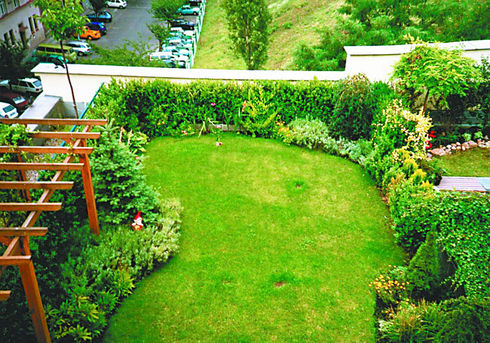Flower EncyclopediaENTER THE WORLD OF FLOWERS |
Other News
Roof garden
Category: Other
04 Jan : 11:34
To view pictures click on them
 For countries in the world as a roof garden is already happening. Necessity or luxury, the interest in greening the roof is constantly growing.
For countries in the world as a roof garden is already happening. Necessity or luxury, the interest in greening the roof is constantly growing.Turning back in history we find that the advantages and favorable impact of roof gardens have been known since ancient times. A striking example are the "Hanging Gardens" in the ancient Semiramis of Babylon, considered one of the seven wonders of the world.
Today, unlike the old, the roof garden is not only unnecessary luxury available to few. It is a necessity imposed by the drastic reduction of green areas in rapidly growing cities and a worsening microclimate.
In many countries grassed roofs are an essential part of architecture, while the roof greening our country still lacks adequate visibility. Roof gardens are built on flat roofs and terraces of residential, public and industrial buildings. Nature of roof gardens and green areas have decided on the territory of underground parking lots and garages. The effect, which can be achieved through planted roof is versatile. On the one hand, the roof gardens are purely decorative significance, which enrich the architectural appearance of buildings during different seasons of the year. On the other - they improve the sanitary - hygiene conditions of the environment, and can significantly reduce the concentration of dust and harmful gases in the air, ionizing the air and increase the oxygen content in it. From an ecological standpoint roof gardens lead to a significant improvement of the microclimate in the cities.
As intended, can distinguish between several types of roof gardens - a dry balcony, roof garden and roof meadow.
Dry terrace is extensive landscaping on flat and sloping roofs with low bushes and tree plants, wild herbs, mosses and grasses. We use drought resistant and can tolerate low preovlazhnyavane periodic plants that possess the ability to regenerate and do not require special care. Depending on the plant height and thickness of soil layer types are thin landscaping gardening, landscaping and an average thickness debelosloyno planting. Extensive landscaping has limited options for layout, low requirements to care for plants and at least load on the roof structure. From an economic perspective it is the most affordable option for roof greening and can be used in roofs unusable.
The roof is usually intensive meadow planting flat and sloped roofs, which makes pochvopokrivni grasses, perennial grasses and shrubs. Requirements of plants to water and nutrients are not large. Diversity of species is also limited. Compared with dry balcony, loading in this type of garden is bigger and plant species require periodic care.
By using and shaping it compares with traditional lawns, which are a place to play, walk and relax. In the roof garden is a special project needed to build the paths, pavements, garden furniture, ponds and plant groups. This type of gardening requires a high load bearing capacity of the roof down even in the construction of the building and intensive care use a variety of vegetation. It covers the flat roofs, occupied by lawns, perennial flowers, shrubs and trees that are planted in soil or in containers can be found. Used fussy plants that require a tiered structure that is based flooring, fittings for irrigation and drainage. Is needed and a special construction of the substrate with sufficient nutrients and water content.
Living conditions and development of plants on the artificial environment created on the roof are not comparable with conditions in their natural habitats. The thickness of the layer of vegetation is limited and there is no natural shading. Plants are subjected to continuous impact of the wind, which grows with increasing height of the building. Moreover, lack of regulation and the natural water and food supplies. Therefore the construction of systems for roof greening has many requirements. Need to firmly root and retain soil layer, prevention of erosion and extracting the roots and retain moisture necessary for life on vegetation, requires the establishment of a vegetation - technical structure divided into layers with different functions.
In its full form design contains the following sections:
- Soil substrate
- Filter layer
- Drainage layer
- Dividing strip
- Korenozashtiten layer
- Hydro
- Roof
Advantages of roof greening
Performance of roof greening offers the following advantages:
- Significantly reduces the impact of street noise - sound insulation increases
- Consumes most of dusty air
- Neozelenen roof in summer and winter may result from fluctuations in temperature to 10 degrees Celsius. Landscaped roof reduces these differences to around 30 degrees Celsius.
- Neozelenen roof in a large quantity of rainwater is lead immediately planted retain 60-70% of it. Following the detention of precipitation leads to increased evaporation from the foliage, leading to lower maximum temperatures and increasing humidity.
- The roof is protected from the effects of ultraviolet radiation on the surface and respectively on waterproofing
- Improve the thermal insulation of roof and can be reduced insulation thickness of the take
- Reduced danger of daily extensions and contractions of roofing materials
- Mechanical damage and others.
Design and construction of roof gardens is related to solving many specific issues of park arrangement of various kinds - biological, technical, aesthetic. The main requirement is that they are built as works of art park, with a unique identity.
In recent years, the green areas in the capital is increasingly giving way to a concrete uniformity. And with it has been suggested and alternative proposals to architects and developers for green spots in the urban environment. Such an idea was planted roof, which has long does not sound exotic. Although these gardens is mainly on the roofs of some hotels and resorts mainly in it, the idea of returning life in the concrete desert has always been well received.
One of the main problems facing such initiatives is the fear of this roof does not leak. But the market offered enough options for a solution to this problem. One method is the isolation with modified bitumen. They have a use in horizontal, vertical or inclined surfaces of concrete, metal, wood or heat-insulating coatings for waterproofing ednoplastova or multilayer system. They can be insulated sloped and flat roofs, balconies, basement walls and roofs - gardens. According to experts Roll bitumen insulation can be used in structures such as retention basins, reservoirs, water towers, irrigation canals, treatment plants and landfills, as well as waterproofing tunnels, bridges and canals.
Good insulation is important for the quantity of plants that can be planted on the roof "onduline - Bulgaria offers Roll bitumen-based waterproofing Bitulin - membranes with high elasticity and resistance to UV rays. Give the company a 10-year warranty, backed by an insurance policy. Membranes are made of high quality bitumen modified by modern technology. Atakten polypropylene processing with improved flexibility, strength, durability and UV resistance of the material. This type of membranes have better properties at high temperatures, better weather resistance and taken with a gas burner or cold bituminous glue. Modification of styrene-butadiene-styrene improves the elastic properties - they are maintained even in extreme low temperatures, increased resistance to chemical agents and elastic memory. These membranes can be affixed with hot bitumen. Other bitumen-based materials offered by onduline are Ondutis - flexible screen attic floor tiles with nonwoven polyester reinforcement and onduline Flashin - adhesive tape based on bitumen, covered with aluminum foil.
From "Orkikem" offer of modified bitumen membranes INDEX, for insulation in new construction and repair of all types of flat and sloped roofs, terraces, gardens and roofs facades, foundations, bridges and viaducts, runways, tunnels, underground parking, hydro construction . For waterproofing of the roof garden and recommended Defend Antiruut - protivokorenni membranes with additives.
Stirofoam a special insulating material extruded polystyrene, which has excellent mechanical stability, high moisture resistance, and resistance to freezing-melting cycles, durable and resistant to decay and decomposition. This material provides both thermal and waterproofing of the roof of the building retains its properties unchanged until the end of her life
Roofmate be used for so-called inverted flat roofs - where the heat insulation panels are laid on the waterproofing. According to specialists from the company the advantages of this isolation prevent temperature extremes, mechanical impacts and UV rays. It is a reduced risk of formation of bubbles and increased life. This system is applied successfully in Europe for over 35 years and is suitable for all types of flat roofs - roofs with unusable gravel and rubble, terraces, outdoor parking, green roofs. When an insulation for a garden, put on the heat insulation layer geopropilenov separator geotextiles, drainage layer, a layer of geotextile separator again and topsoil. Usable in isolation of flat roofs on the insulating panels can be placed gravel - up to 3-5 cm thick, which are placed on concrete or mosaic tiles on a dry basis.
MAXIM offer Belgian rubber membrane with high resistance and ca elestichnost UV rays and sudden temperature changes Prelasti, which ensures safe insulation of flat, sloping roofs and ozeleni, pools, tanks, metal and concrete halls, bridges, tunnels, neftohranilishta and tombs for toxic waste. Here, the membrane service life commensurate with that of the building and setting it as a quick and easy connections to cure with high temperature and pressure. To make on any basis: concrete, sheet metal, wood, old bitumen, all thermal insulation, as well as directly on the soil. Be secured in three ways: by zatiskane by sticking with neuprenovi and polyurethane adhesives or mechanical without pierced by a special membrane system, patented by the producer. Individual lanes are connected by vulcanization. This yields a dual-hinge thickness and the same homogenous structure as the canvas, which ensures the strength of the insulation. More than 55 percent of roofs in the U.S. and Japan are covered by such a membrane, indicated by the company.
It can be stretched to 7,5 times, and then to hold its original shape without a million times to change its composition. It is possible that the isolation canvas be dismantled and installed on another roof (when upgrading) without changes to their characteristics. The product allows the roof of a building to be planted only by placing the soil and sow plants without the necessary additional protections. Rubber membrane is resistant to penetration of plant roots, allowing a small support and a thin layer of soil to develop greater plant diversity.
Roll the price of bitumen membranes is about 4.9 EUR / sq. m. Slightly expensive rubber insulation, but the average price of materials and placement of heat and waterproofing of the roof is 30 to 50 leva / sq. m
| ecological standpoint gases in the air hygiene conditions harmful gases flat roofs |
Comments are turned off for this item0
| ecological standpoint gases in the air hygiene conditions harmful gases flat roofs |























































